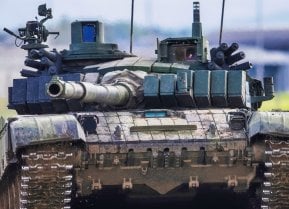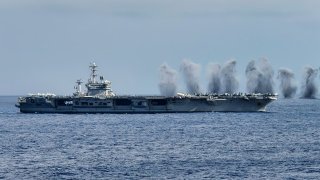UUV: Three Letters That Could Mean the Aircraft Carrier Age Is Over
The transition from battleships to aircraft carriers as the dominant force in naval warfare is a well-known historical pivot, and now, another transformation is underway with the emergence of unmanned underwater vessels (UUVs).
Summary: The transition from battleships to aircraft carriers as the dominant force in naval warfare is a well-known historical pivot, and now, another transformation is underway with the emergence of unmanned underwater vessels (UUVs). The U.S. Navy, historically slow in adapting to new naval technologies, faces a similar challenge with the rise of UUVs.
-Despite ongoing large-scale shipbuilding projects like the Gerald R. Ford-class carriers and Constellation-class frigates, the Navy's investment in UUVs is relatively minor, with a significant reduction in the budget for small- and medium-sized UUVs.
-However, the strategic potential of UUVs in modern naval warfare is becoming increasingly apparent, with their capabilities to perform dangerous and complex tasks like maritime surveillance, minehunting, and infrastructure protection. As geopolitical tensions, particularly in the Indo-Pacific, continue to escalate, the U.S. Navy is urged to enhance its focus on UUV technology to maintain its competitive edge and adapt to the new dynamics of naval warfare.
UUVs: The Next Revolution in Naval Warfare
Just two centuries ago, most navies around the world consisted of "wooden ships and iron men." By the end of the 19th century, though, the age of steel had set in, and the arrival of the British Royal Navy's HMS Dreadnought spurred a global naval arms race.
The age of the battleship was actually short-lived. The large, lumbering big-gun warships proved vulnerable to combat aircraft. And while the U.S. Navy's nuclear-powered supercarriers are still the kings of the sea, their day also is passing.
We are entering the age of the sea drone, or UUV.
We could soon see unmanned underwater vessels supporting manned surface vessels and submarines. Large UUVs might even be motherships for smaller, mission-specific UUVs that act as decoys, carry out reconnaissance, or serve as demolition drones.
The U.S. Navy worries that history might repeat itself. The Navy lagged behind other sea services in battleship development, and while it was an early pioneer of carrier-based operations, the Imperial Japanese Navy quickly surpassed it in the interwar period, forcing the U.S. to play catch-up.
According to a report from Reuters, the Navy is now lagging in the development of unmanned vessels, because the Pentagon remains wedded to large-scale shipbuilding projects.
The Navy’s main focus right now is to replace its aging Nimitz class of nuclear-powered supercarriers with newer Gerald R. Ford-class flattops. The Navy is also sailing forth with its Constellation-class multi-mission guided-missile frigates and its DDG(X) next-generation guided-missile frigates. A lot is riding on these programs, given the failures of Zumwalt-class destroyers and Littoral Combat Ships.
In many ways, the Navy is trying to correct past mistakes with newer classes of the same ships. Through it all, it might be overlooking the future platforms of naval warfare. This could be the biggest mistake of all.
"The lethal effectiveness of sea drones has been demonstrated in the Black Sea where Ukraine has deployed remote-controlled speed boats packed with explosives to sink Russian frigates and minesweepers since late 2022," Reuters reported.
The Navy has not entirely forgotten UUVs. Numerous projects are in the works. Last August, Deputy Secretary of Defense Kathleen Hicks announced an initiative dubbed Replicator to deploy hundreds of small, relatively cheap air and sea drones within the next 18-24 months to counter China's growing military threat, notably in the Indo-Pacific region.
Drop in the Ocean
Even with these programs, the amount being invested in UUVs remains just a fraction of the sea service's total budget. According to the Navy's budget request for Fiscal Year 2025, the service wants $101.8 million for small- and medium-sized UUVs. That is down from $172 million last year. It is just a speck of the Navy's $63 billion budget for FY25.
The other problem is that even as programs move forward, the Navy still hasn't dedicated personnel to working with UUVs. According to two Navy sources who spoke to Reuters, there aren't enough sailors trained to pilot drones, or to analyze the vast swathes of data the UUVs gather.
One spokesperson told the news agency that efforts are underway to improve both the collection and analysis of data.
Attack of the Drones
Their exact capabilities are undefined, but it is widely expected that UUVs could take on missions too costly and requiring too many vessels for manned naval fleets. That would include maritime surveillance, minehunting, and protecting critical undersea infrastructure like gas pipelines and fiber-optic cables.
Swarms of small sea drones might also shield valuable crewed assets including aircraft carriers and submarines. In turn, they could strike troop-carrying ships from China if it tries to invade Taiwan, Bryan Clark, an advisor to the Navy on autonomous craft and a senior fellow at the Hudson Institute, explained to Reuters.
The age of the sea drone has arrived. The United States cannot afford to fall behind. Just as combat aircraft ended the battleship’s dominance, so UUVs could humble the aircraft carrier.
Author Experience and Expertise: Peter Suciu
Peter Suciu is a Michigan-based writer. He has contributed to more than four dozen magazines, newspapers, and websites with over 3,200 published pieces over a twenty-year career in journalism. He regularly writes about military hardware, firearms history, cybersecurity, politics, and international affairs. Peter is also a Contributing Writer for Forbes and Clearance Jobs. You can follow him on Twitter: @PeterSuciu. You can email the author: [email protected].


